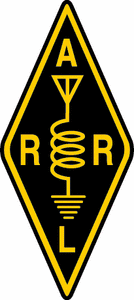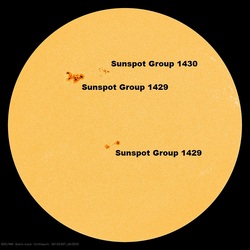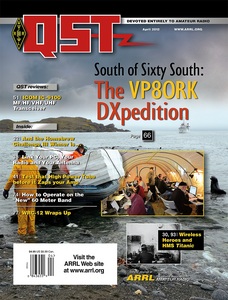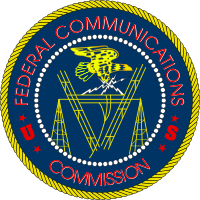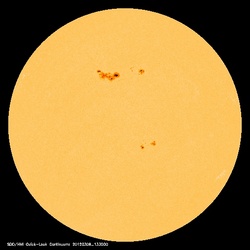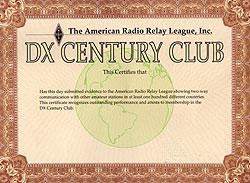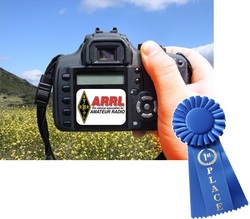 March 8, 2012 John E. Ross, KD8IDJ, Editor
| |||||||||||
+ Available on ARRL Audio News. + Dayton Hamvention®: Dayton Hamvention Honors QST Technical Editor Joel Hallas, W1ZR, with Technical Achievement Award
On March 6, the Dayton Hamvention® Awards Committee announced the recipients of Hamvention's four annual awards. QST Technical Editor Joel Hallas, W1ZR, was named the winner of the Technical Achievement Award. The recipient of the Amateur of the Year is S. Suri, VU2MY. Steven Betza, WZ2V, was selected as the recipient of the Special Achievement Award. The Deutscher Amateur Radio Club -- Germany's IARU Member-Society -- was selected as the Club of the Year. Read more here. + On the Air: New 60 Meter Privileges Now in Effect As of March 5, US amateurs have new privileges on the 60 meter band. In addition to an increase in effective radiated power from 50 to 100 W, hams can now transmit CW and PSK31 on the following channel-center frequencies:
Amateurs can also transmit USB voice and PACTOR III on the following suppressed carrier frequencies (the frequencies typically shown on transceiver displays):
For more information, please see 60 Meter Operations -- New Privileges and Recommended Practices, published by the ARRL HF Band Planning Committee. A revised ARRL band chart is also available. Watch for the article "New Privileges on 60 Meters" by ARRL Regulatory Information Manager Dan Henderson, N1ND, in the April 2012 issue of QST. On the Air: ARRL Seeks Comments on Proposed 9 cm Band Plan
A few months ago, the ARRL UHF/Microwave Band Plan Committee asked the Amateur Radio community about current, planned and projected uses of the amateur bands between 902 MHz and 3.5 GHz. The response was beyond our expectations, with hundreds of comments and suggestions received. Thanks to all of you who took the time to share information with us. After reading the feedback, the committee began working on the band plans; the first draft plan ready for review is for the 9 cm band (3300-3500 MHz). Read more here. + Propagation News: Active Sunspot Region 1429 Produces Solar Flares, Coronal Mass Ejections This week has been an active week for our Sun. An X-1.1 class solar flare erupted from the Sun on March 4 at 11:13 PM EST (0413 UTC March 5), sending an explosion of plasma and charged particles -- a coronal mass ejection (CME) -- hurtling through space. Forecasters at NOAA's Space Weather Prediction Center are saying that this CME should miss Earth, but it will hit Mercury and Venus. Then on March 6 at 7:28 PM EST (0028 UTC March 7), the Sun released a solar flare, the strongest one this year. The X-5 class flare hurled another CME into space, but it is too soon to tell if this is an Earth-directed flare. This activity is coming from sunspot 1429, which is currently making its way around the northern hemisphere of the Sun. Sunspot 1429 -- which emerged on the Sun on March 2 and is estimated to be at least four to five times larger than Earth -- is slowly turning to face Earth, so if any such eruptions do occur, they are increasingly likely to be geoeffective.
When a CME hits the Earth's atmosphere -- approximately 72 hours after exploding on the Sun -- the low bands will be depressed and signals will be weaker the lower the frequency. The absorption rate will be most severe on 160 meters, less on 80 and somewhat better on 40 meters. The maximum usable frequency (MUF) -- the highest frequency at which a radio wave can propagate between given terminals by ionospheric propagation alone, independent of power -- will be lower and auroral propagation on the VHF bands is quite possible. When aurorae occur, the electrons hit the ionosphere at the North and South geomagnetic poles, creating ionization. Waves that would normally travel off into space are bouncing off the aurora and being redirected back toward Earth. This can create opportunities for long-distance propagation via VHF and UHF. Read more here. + Don't Be Fooled: Check out the April Issue of QST This April issue of QST remembers the wireless heroes of the RMS Titanic and the SS Carpathia 100 years ago, and also takes readers on a voyage to the South Orkney Islands for the VP8ORK DXpedition -- and more. So set aside a couple of hours, grab a beverage and get ready to have some radio fun with the April issue of QST. In 2011, the Third Annual ARRL Homebrew Challenge presented the toughest challenge to date. In 2006, we asked readers to build a 5 W PEP 40 meter sideband and CW transceiver. In 2009, we upped the ante, looking for a 50 W linear amplifier to go along with the transceiver. For 2011, we challenged hams to come up with a single or multiband transceiver for 6 and/or 10 meters. Find out who walked away with the honors in "Homebrew Challenge III - And the Winner Is..." by QST Technical Editor Joel R. Hallas, W1ZR.
Eric Keerbs, AD7HM, discovers a way to let your radios talk to your computer using an interface converter in his article "Level Converter to Allow Full Control of Peripherals by Computer or Radio." In "A Transceiver-to-Amplifier Interface," Ed Toal, N9MW, presents an interface that you can use to safely switch your older linear amplifier from your new transceiver. Paul Danzer, N1II, takes a look at window line and standing wave ratio in his article "Balanced Line SWR Measurement." It's been 100 years since the RMS Titanic -- heralded as "unsinkable" -- struck an iceberg and sank to the bottom of the Atlantic, taking 1511 passengers and crew with it. Retired US Coast Guard Reserve Commander Richard Paton takes a look at the tragedy -- with a focus on Jack Phillips and Harold Bride, the two Marconi wireless operators on the Titanic -- in his article "Radio's Role in the Titanic Disaster." The "Vintage Radio" column profiles the wireless operator aboard the rescue ship, the SS Carpathia. The VP8ORK DXpedition to the tip of the Antarctic Peninsula saw seals, dolphins and big pileups. Join Michael Mraz, N6MZ, as he recounts the Microlite Penguin DXpedition to the South Orkney Islands in "South of Sixty South." Make plans to join the ARRL and the ARRL EXPO at the 2012 Dayton Hamvention and the 2012 ARRL National Convention in California. Find out all you need to know about these two headlining events in "ARRL EXPO 2012 -- Save the Dates" by ARRL Marketing Manager Bob Inderbitzen, NQ1R. NCJ Managing Editor Rick Lindquist, WW3DE, takes a look at the ICOM IC-9100 MF/HF/VHF/UHF transceiver in this month's Product Review. He says the rig is "compact and versatile. The IC-9100 handles almost any type of operating on the 160 meter through 2 meter bands, plus 70 and 23 cm." Of course, there are the usual columns you know and expect in the April QST: Happenings, Hints & Kinks, The Doctor Is In, Short Takes, How's DX and more. Look for your April issue in your mailbox. QST is the official journal of ARRL, the national association for Amateur Radio. QST is just one of the many benefits of ARRL membership. To join or renew your ARRL membership, please see the ARRL Web page. + FCC News: FCC Reduces Forfeiture for Florida Man Accused of Using Unauthorized Equipment
In November 2011, the FCC issued a Notice of Apparent Liability for Forfeiture in the amount of $10,000 to Michael Perry of Cross City, Florida. In a Forfeiture Order released on March 6, the FCC reduced the forfeiture that Perry must pay to $450. Perry was accused of operating a radio transmitter without the requisite FCC authorization and his failure to operate a Citizens Band station, "willfully violat[ing]" Section 301 of the Communications Act of 1934, as amended and Sections 95.409 (by operating an unlicensed and non-certificated CB transmitter) and 95.411 (by operating an unlicensed radio transmitter with two amplifiers) of the FCC's rules. Read more here. ARRL Annual Awards: Nominations for ARRL Awards Now Open
Each year, the ARRL Board of Directors has the opportunity to select recipients for a number of awards in various categories that honor Amateur Radio operators. The nomination period is now open for the ARRL awards that are designed to recognize educational and technological pursuits in Amateur Radio, as well as an award to honor a young Amateur Radio operator. ARRL members can nominate hams for the Herb S. Brier Instructor of the Year Award, the Hiram Percy Maxim Award, the ARRL Microwave Development Award, the ARRL Technical Service Award, the ARRL Technical Innovation Award and the Knight Distinguished Service Award. Read more here. Solar Update
Tad "If we can make it through the night we will see the Sun" Cook, K7RA, reports: This has been quite a week for dramatic solar activity: The average daily sunspot number was up nearly 26 points to 69.4, while the average daily solar flux rose nearly 17 points to 121.9. The latest forecast has solar flux at 140 on March 8-9, 135 on March 10-11, 130 on March 12-13, 125 on March 14-15, then 130, 125, 120, 115, 115, 110 and 110 on March 16-22, then back down to 105 on March 23-25. The predicted planetary A index for March 8-10 is 75, 28 and 15, then 10 on March 11-13, 5 on March 14-16, then 12, 15, 10, and 8 on March 17-20, and 5 on March 21-27. Look for more information on the ARRL website on Friday, March 9. For more information concerning radio propagation, visit the ARRL Technical Information Service Propagation page. This week's "Tad Cookism" is brought to you by Good Charlotte's March On. + DXCC News: Four Operations Approved for DXCC Credit
ARRL DXCC Manager Bill Moore, NC1L, reports that four operations -- the current VK0TH and AX/VK0TH (Macquarie Island) operation, the current T6BP (Afghanistan) operation, the 2011 6O0M (Somalia) operation and the December 2011-January 2012 9U3TMM (Burundi) operation -- have been approved for DXCC credit. "If you have had these operations rejected in a recent application, please send an e-mail to the ARRL DXCC Desk," Moore said. "Please note that due to heavy e-mail volume, you may not receive a reply. Once updated, results will appear in Logbook of The World (LoTW) accounts, as well as online in the daily listings." This Week in Radiosport This week:
Next week:
All dates, unless otherwise stated, are UTC. See the ARRL Contest Branch page, the ARRL Contest Update and the WA7BNM Contest Calendar for more information. Looking for a Special Event station? Be sure to check out the ARRL Special Event Stations Web page. + Enter the Seventh Annual ARRL Photo Contest!
Have you ever wanted to see a photo of yours in QST, the annual ARRL Amateur Radio Calendar or another ARRL publication? Well, here's your chance! If you're among the winners, not only will your photographic skill be propagated far and wide, but we're offering $100 as the First Prize. The winning photo and three runners-up will be published in QST. All submitted photos will also be considered for the 2013 ARRL Calendar. Read more here. New QuickStats Poll Now Available on ARRL Website Four new poll questions have just been published on the QuickStats page on the ARRL website. Let your voice be heard!
Questions in this month's QuickStats poll:
Visit the QuickStats page and be sure to bookmark it in your browser. Results from this QuickStats poll will be published in the June 2012 issue of QST on the QuickStats page, located in the rear advertising section of the magazine. Along with monthly poll results, QST QuickStats offers colorful charts and graphs that highlight interesting Amateur Radio statistics. Upcoming ARRL Section, State and Division Conventions and Events
To find a convention or hamfest near you, click here. ARRL -- Your One-Stop Resource for Amateur Radio News and Information Join or Renew Today! ARRL membership includes QST, Amateur Radio's most popular and informative journal, delivered to your mailbox each month. Subscribe to NCJ -- the National Contest Journal. Published bi-monthly, features articles by top contesters, letters, hints, statistics, scores, NA Sprint and QSO Parties. Subscribe to QEX -- A Forum for Communications Experimenters. Published bi-monthly, features technical articles, construction projects, columns and other items of interest to radio amateurs and communications professionals. Free of charge to ARRL members: Subscribe to the ARES E-Letter (monthly public service and emergency communications news), the ARRL Contest Update (bi-weekly contest newsletter), Division and Section news alerts -- and much more! Find us on Facebook. Follow us on Twitter. ARRL offers a wide array of products to enhance your enjoyment of Amateur Radio Donate to the fund of your choice -- support programs not funded by member dues! Click here to advertise in this newsletter. | |||||||||||

